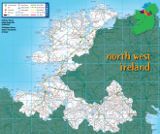North West Ireland Tourism
Visitor Guide to Mayo, Sligo, Donegal, Roscommon, Leitrim, Cavan & Monaghan
Visitor Guide to Mayo, Sligo, Donegal, Roscommon, Leitrim, Cavan & Monaghan
| 0-9 A B C D E F G H I J K L M N O P Q R S T U V W X Y Z |
Glencolumbkille
Glencolumbkille and Malin Beg are ideal bases for visitors who wish to explore the wonderful delights of the Slieve League Peninsula. With stunningly clear Atlantic water set against a backdrop of impressive mountains, this is a picturesque and wonderful land. Hikers and cliff walkers will be keen to ramble across the Slieve League Mountain which, at 600m in height, is home to Ireland’s highest sea-cliffs. The Slieve League Cliffs differ quite radically from the Cliffs of Moher, being slightly less exposed to the onslaught of the Atlantic, and are very well worth visiting. Glencolumbkille is very much a favourite with history enthusiasts too, having an abundance of ancient ruins spanning from stone age monuments, up to the castles, forts, and church monuments of more recent times.
Many houses dot the slopes of Glencolumbkille, which runs back in between the hills from Glen Bay, in surroundings at once peaceful and strikingly picturesque. A popular holiday destination for families, Glencolumbkille lies in the heart of the Irish-speaking area of South Donegal.
The coast from Carrigan, to Glencolumbkille, and on to Loughros Bay, boasts some of the finest cliff scenery in Ireland. “Glencolumbkille” itself translates into English as “the valley of Colm Cille”. Saint Colm Cille is one of Ireland’s three patron saints, the others being Saint Patrick and Saint Brigid. Colm Cille, together with a community of early Christian followers, lived here in the valley for a time. Indeed, the ruins of several of their churches can still be seen to this day. Tucked into the rugged landscape of the south west Gaeltacht of County Donegal, the village is still an Irish speaking community.
The district round Glencolumbkille was once famous as the parish of Father James McDyer who championed the rights of rural people. Indeed, he helped establish a number of very successful community based industries in the area. He was transferred to Glencolumbkille parish in 1951, and when he arrived he saw that it was suffering from high levels of unemployment and emigration. This was not a new problem for the area, but rather a way of life. During the previous seventy years the Parish has lost 60% of its population due to the problems of poor land, remoteness from centres of population, and lack of industry. Father McDyer was determined to do all he could to break this cycle, and he set about developing local industry and amenities, some of which are hugely successful to this day. In 1967 he founded Glencolumbkille Folk Village which was built in the form of a traditional settlement. Each of its houses was an exact replica of a dwelling used by local people in each of the three successive centuries, 18th 19th and 20th. Each of its houses is equipped with the furniture, artefacts and utensils of its particular period. The Glencolumbkille Folk Village was an immediate success, and is now one of the major tourist attractions in the area.
Book Glencolumbkille Accommodation
Many houses dot the slopes of Glencolumbkille, which runs back in between the hills from Glen Bay, in surroundings at once peaceful and strikingly picturesque. A popular holiday destination for families, Glencolumbkille lies in the heart of the Irish-speaking area of South Donegal.
The coast from Carrigan, to Glencolumbkille, and on to Loughros Bay, boasts some of the finest cliff scenery in Ireland. “Glencolumbkille” itself translates into English as “the valley of Colm Cille”. Saint Colm Cille is one of Ireland’s three patron saints, the others being Saint Patrick and Saint Brigid. Colm Cille, together with a community of early Christian followers, lived here in the valley for a time. Indeed, the ruins of several of their churches can still be seen to this day. Tucked into the rugged landscape of the south west Gaeltacht of County Donegal, the village is still an Irish speaking community.
The district round Glencolumbkille was once famous as the parish of Father James McDyer who championed the rights of rural people. Indeed, he helped establish a number of very successful community based industries in the area. He was transferred to Glencolumbkille parish in 1951, and when he arrived he saw that it was suffering from high levels of unemployment and emigration. This was not a new problem for the area, but rather a way of life. During the previous seventy years the Parish has lost 60% of its population due to the problems of poor land, remoteness from centres of population, and lack of industry. Father McDyer was determined to do all he could to break this cycle, and he set about developing local industry and amenities, some of which are hugely successful to this day. In 1967 he founded Glencolumbkille Folk Village which was built in the form of a traditional settlement. Each of its houses was an exact replica of a dwelling used by local people in each of the three successive centuries, 18th 19th and 20th. Each of its houses is equipped with the furniture, artefacts and utensils of its particular period. The Glencolumbkille Folk Village was an immediate success, and is now one of the major tourist attractions in the area.
How to get to Glencolumbkille
By bus or car. Bus Eireann, and several local carriers, provide daily services from Donegal. Alternatively take the N56 and R263 west from Donegal, via Killybegs, to Glencolumbkille.Where to stay in Glencolumbkille
Glencolumbkille has great range of quality accommodation options including hotels, hostels, self-catering holiday homes, guesthouses and B&B's.Book Glencolumbkille Accommodation
Explore more
Glencolumbkille is surrounded by beautiful coastal towns. Don't miss Ardara and Rosbeg if you are travelling north, and don't miss Rathlin O’Beirne Island and Malin Beg if you are travelling south.Things to do in Glencolumbkille
- Try your hand at fishing from the pier at Malin Beg. The pier is accessed by a series of very steep stone steps. This harbour is built into a natural shelter so even on rough days it is comfortable to fish here. Expect to catch mostly pollack and coalfish, but also mackerel, snapper, and wrasse. If night fishing set up a line for conger eel at the end of the slipway. There are usually plenty of dogfish around in September.
- Visit Glencolumbkille Folk Village Museum with its replica thatched cottages which give a glimpse into life as lived in past centuries.
- You just can’t miss Silver Strand, one of the most beautiful beaches you’ll find anywhere!
Glencolmcille Folk Village Museum
Glencolmcille Folk Village Museum is located in...
Glencolmcille
Co. Donegal
Co. Donegal
Sort listings by: Alphabetic ascending | descending








